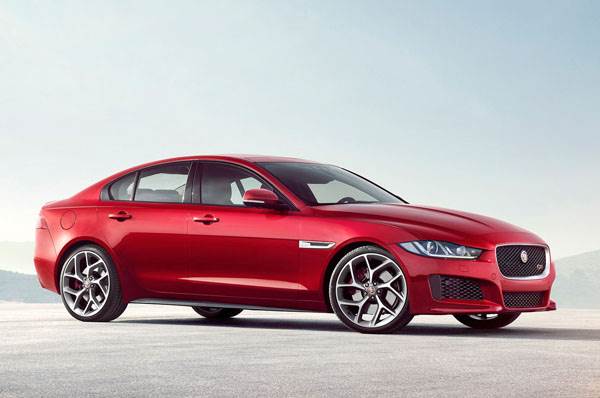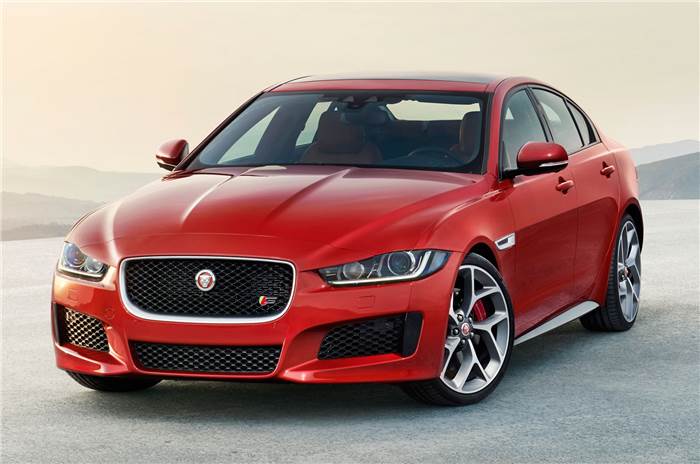Jaguar has taken the wraps off its new BMW 3-series rival, the XE.
Jaguar will be hoping the XE’s impressive range of technical innovations – including a new chassis, new materials, new body, new assembly works, new engine range and a new engine plant – will help it to take on the 3-series as well as the Mercedes-Benz C-class and Audi A4.
The XE’s success has huge implications for Jaguar’s ability to fulfill its new model plan of the future.
The car does not set out to shock, however. It employs and extends the new-generation Jaguar design style introduced with the XF sedan in 2008 and developed more recently in the F-type sports car range.

The new Jaguar is an all-aluminium, four-door, rear-drive sedan – slightly bigger than a 3-series but smaller than an A4 – that uses riveting and bonding techniques developed over the past decade that make it Jaguar’s lightest, stiffest sedan yet.
The XE will become Jaguar’s entry-level model. It is tipped to sell well over 100,000 units a year globally, when production hits its stride, and even more when other body styles are launched.
Design
Design boss Ian Callum says that the new Jaguar XE will become “the defining sports sedan for Jaguar”.
His design team’s way of fulfilling that brief, he explains, was to start by giving the car a low driving position, a long, coupé-like roofline like the XF and placing the cabin as far rearward as possible to allow the car a long bonnet and short boot while still providing decent (although admittedly not class-leading) legroom and headroom in the rear.
Callum acknowledges the debt that the XE owes to the XF, which pioneered many facets of Jaguar’s modern design style: the sculpted bonnet with strong ‘power bulge’, the narrow headlights and ‘J-blade’ running lights, the rising waistline and long, confident curve of the coupé roof.
The rear lights he describes as “a horizontal line intersecting a roundel” and they owe something both to the F-type and originally the E-type, just as the rounded window of the rear door carries suggestions of the Jaguar Mark 2.

No one would suggest that this was anything but a Jaguar for 2015, but allusions to the marque’s rich history are clear in many places. Jaguar’s designers are proud of their equal partnership with the XE’s engineers and aerodynamicists.
In its most frugal form, on specially designed 17-inch wheels (as opposed to the 18s, 19s and 20s also available), the car’s drag coefficient is an impressive 0.26. The car’s lowness and shrink-wrapped lines have helped to keep the frontal area low, designers say.
Chassis and suspension
The XE is very close in all major dimensions to the A4 and 3-series (which are literally within a few millimetres of one another). It sits between the German pair in overall length, but its wheelbase is about 25mm longer than either, and it sits about 15mm lower on its standard suspension.
However, its secret weapon is a riveted and bonded aluminium monocoque body structure, currently made partly of a recycled alloy that the company wants to use for 75 per cent of suitable components by 2020.
Without disclosing the actual weights – they’ll come at next month’s Paris motor show – engineers reckon their new car is the lightest and stiffest Jaguar saloon yet.
“The XE’s structure is absolutely at the cutting edge of what is achievable today,” says Mark White, Jaguar’s chief technical specialist. Given that a BMW 320d saloon weighs just over 1400kg and the original aluminium XJ saloon undercut its rivals by about 200kg back in the day, you’d expect a diesel XE to weigh between 1200 and 1250kg to extract a decent dividend from its exotic construction.

The XE is said to have the most sophisticated suspension in its class to support a claim that it will establish new class benchmarks for ride and handling.
Where others use efficient, affordable MacPherson strut suspension up front, the XE has a widely spaced double wishbone layout (complete with the characteristic ‘goose neck’ upright similar to that used for the XK and XF) that delivers superior wheel control but costs more.
The subframe-mounted independent rear suspension is even more exotic: not a conventional multi-link system but instead dubbed Integral Link, for cost reasons usually seen on cars in the XF price range, that delivers ideal lateral stiffness for fine handling but allows considerable longitudinal compliance to build refinement, while keeping excellent toe control.
To minimise unsprung weight and provide best ride comfort, all of the major components are made in aluminium. Depending on the engine’s power output, there are three different disc brake sizes – all with new-design single-piston calipers – and a choice of four wheel sizes (and eight alloy wheel designs).
The XE is the first Jaguar in history to use electric power steering, a move described as “a big step” by Mike Cross, the chief engineer charged with ensuring that every XE drives like a real Jaguar.
“It’s a step we took confidently,” says Cross, “because the range of possibilities in fine tuning enabled us to achieve the responsive, connected steering feel a Jaguar needs.”
The XE’s chassis package utilises intelligent technologies more than any previous Jaguar. The car takes the learning from Land Rover’s Terrain Response system and adapts it to become ASPC (All Surface Progress Control), which lets drivers select one of four ideal settings: Dynamic, Normal, Eco or Winter.
Also available is a suite of the electronic driver aids that are becoming more and more common in premium cars: autonomous braking, adaptive cruise, parking assist, reverse traffic detection, blind spot monitoring and road sign recognition.
Interior and equipment
The XE’s cabin is designed to project quality, but despite being more spacious in the front than previous Jaguar models is still relatively compact.

Ultimately, cabin space has given way to sporting pretensions. At first glance, the cabin lacks the distinction of the C-class, but it has a deep centre console that affords a pleasant, driver-focused aura and buyers get a choice of textures and aluminium or piano black dashboard finishes as alternatives to traditional wood veneers.
There is an all-new infotainment system called InControl, based around an eight-inch central touchscreen claimed to feature intuitive graphics and quick responses.
Bluetooth, updatable navigation, audio streaming and USB connectivity are offered, and the car can become a wi-fi hotspot, via an efficient roof antenna, allowing up to eight devices to be connected at once. Apps are available to promote conference calls, parking and traffic information and a myriad of other functions.
Jaguar will launch the XE sedan in India during the festive season of next year. The Indian-bound XE sedan will come with higher ground clearance and tuned suspension suitable for our roads.
Powertrain
Jaguar will talk about only two of what appears to be at least five powertrains for its 2015 launch.
The first is the performance-orientated supercharged 3.0-litre V6, which is also used in the F-type, and the other is an all-new mainstream diesel, a 2.0-litre turbocharged four-cylinder unit from the Wolverhampton-built Ingenium range that will make its debut in this car but spread rapidly through the Land Rover and Jaguar model line-ups.
The petrol V6, fed by a twin-vortex, Roots-type blower, has peak outputs of 335bhp and 332lb ft of torque and propels the quickest XE to a governed top speed of 250kph, with 0-100kph acceleration of just 4.9sec on the way.
The diesel – designed from a clean sheet and built for light weight and low friction has variable exhaust cam timing, plus exhaust after-treatment so that it can meet latest Euro 6 standards. It produces a healthy 161bhp.

For now, the engines will be available with either six-speed manual gearboxes (a special lightweight version for the diesel) or adapted versions of the ubiquitous eight-speed ZF automatic; although engineers suggest that there might be a future role here for the nine-speed auto already seen in the Range Rover Evoque.



Comments
Member Login
Personal Details
No comments yet. Be the first to comment.